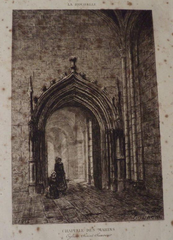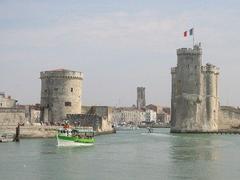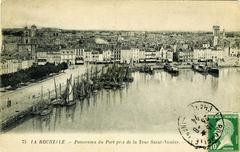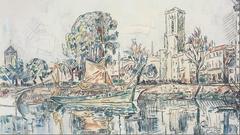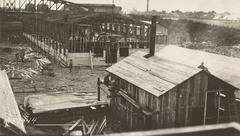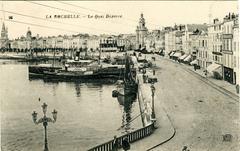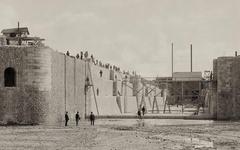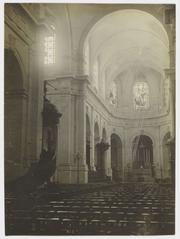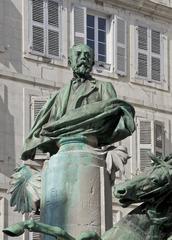
Comprehensive Guide to Visiting Église Saint-Sauveur, La Rochelle, France
Date: 19/07/2024
Introduction
Nestled in the heart of La Rochelle, France, Église Saint-Sauveur is a historical gem that epitomizes the rich cultural and architectural heritage of this coastal city. Originally constructed in the 12th century, the church has endured significant trials, including multiple cycles of destruction and rebuilding. These events have culminated in the Baroque-style structure that stands today, a testament to the resilience and adaptability of the local community. The church’s architectural features, from its intricate façade to its vaulted ceilings, offer a visual feast for history enthusiasts and architecture aficionados alike. Visitors can delve into a storied past marked by religious conflicts, particularly during the Wars of Religion and the Siege of La Rochelle, which have left indelible marks on the church’s history (Explore the Rich History and Visitor Information of Église Saint-Sauveur in La Rochelle). Beyond its historical significance, Église Saint-Sauveur remains a vibrant part of the community, hosting religious ceremonies, cultural events, and community gatherings. Whether you’re a tourist seeking to explore La Rochelle’s historical sites or a local participating in community activities, this guide offers comprehensive coverage to enhance your visit.
Table of Contents
- Introduction
- History of Église Saint-Sauveur
- Architectural Features
- Artistic Contributions
- Modern-Day Significance
- Preservation Efforts
- Visitor Information
- Notable Events and Figures
- FAQ
- Conclusion
- Further Reading and Resources
- Call to Action
History of Église Saint-Sauveur
Origins and Early History
Église Saint-Sauveur, located in La Rochelle, France, has a rich history that dates back to the medieval period. The original church was constructed in the 12th century, serving as a significant religious and community center for the burgeoning port city. La Rochelle, known for its strategic maritime position, saw the church as a symbol of both spiritual and civic pride.
Destruction and Rebuilding
The church has faced numerous challenges throughout its history, including multiple instances of destruction and rebuilding. One of the most significant events occurred during the Wars of Religion in the 16th century. La Rochelle, a stronghold of Protestantism, was besieged by Catholic forces. In 1568, the original Église Saint-Sauveur was destroyed by fire during these conflicts. The church was rebuilt in the early 17th century, only to be destroyed again by another fire in 1687.
17th and 18th Century Reconstruction
The current structure of Église Saint-Sauveur largely dates from the late 17th and early 18th centuries. The reconstruction efforts were spearheaded by the architect François Le Duc, also known as Toscane. The new design incorporated elements of both Gothic and Baroque architectural styles, reflecting the evolving tastes and influences of the period. The church was finally completed in 1718, with its distinctive façade and interior features that can still be seen today.
Architectural Features
Baroque Influence
The Baroque style, which flourished in Europe from the late 16th century to the early 18th century, is characterized by dramatic expressions, grandeur, and detailed ornamentation. Église Saint-Sauveur embodies these elements through its elaborate façade and intricate interior decorations. The church’s façade features a combination of classical columns and pilasters, which create a rhythmic verticality, drawing the eye upwards. This design choice is typical of Baroque architecture, aiming to evoke a sense of awe and grandeur.
Façade and Exterior
The church’s façade is divided into three vertical sections, each adorned with pilasters and topped with a triangular pediment. The central section is the most prominent, featuring a large arched doorway flanked by Corinthian columns. Above the doorway, a niche houses a statue of Saint Sauveur, the church’s patron. The upper levels of the façade are decorated with intricate carvings and reliefs, showcasing scenes from the Bible and the lives of saints.
The exterior walls of the church are constructed from local limestone, giving the building a distinctive pale hue. The use of limestone not only provides structural integrity but also adds to the aesthetic appeal, as the stone’s texture and color change subtly with the light throughout the day.
Interior Design and Ornamentation
Nave and Aisles
The interior of Église Saint-Sauveur is equally impressive, with a spacious nave flanked by two aisles. The nave is covered by a barrel vault, a hallmark of Baroque architecture, which enhances the acoustics and creates a sense of openness. The aisles are separated from the nave by a series of arches supported by robust columns. These columns are adorned with Corinthian capitals, adding to the overall decorative scheme.
Altars and Chapels
The church houses several altars and chapels, each dedicated to different saints and adorned with exquisite artwork. The main altar, located at the east end of the nave, is a masterpiece of Baroque art. It features a large altarpiece depicting the Transfiguration of Christ, surrounded by gilded sculptures and intricate woodwork. The side chapels are equally ornate, with altarpieces and statues that reflect the religious fervor and artistic talent of the period.
Stained Glass Windows
One of the most striking features of Église Saint-Sauveur is its collection of stained glass windows. These windows, which date back to the 19th century, depict various biblical scenes and saints. The vibrant colors and intricate designs of the stained glass create a mesmerizing play of light within the church, enhancing the spiritual atmosphere. The windows are not only artistic masterpieces but also serve a didactic purpose, illustrating key events and figures from Christian history.
Structural Innovations
Use of Limestone
The use of local limestone in the construction of Église Saint-Sauveur is a notable aspect of its architectural significance. Limestone is a durable material that has been used in many historical buildings in the region. Its availability and workability made it an ideal choice for the church’s construction. The stone’s natural beauty and ability to withstand the elements have contributed to the church’s longevity and aesthetic appeal.
Vaulting Techniques
The church’s barrel vault is a prime example of the advanced engineering techniques employed during its construction. Barrel vaults are continuous arches that create a tunnel-like effect, providing both structural support and an impressive visual element. The use of barrel vaulting in Église Saint-Sauveur not only enhances the acoustics but also allows for larger, unobstructed interior spaces, which are essential for accommodating large congregations.
Artistic Contributions
Sculptures and Reliefs
The sculptures and reliefs that adorn Église Saint-Sauveur are significant contributions to its architectural and artistic heritage. These works of art, created by skilled artisans, depict various religious themes and figures. The detailed carvings on the façade, altars, and chapels showcase the high level of craftsmanship and artistic talent of the period. These sculptures and reliefs not only enhance the church’s aesthetic appeal but also serve as important religious symbols and teaching tools.
Paintings and Frescoes
The interior of the church is adorned with numerous paintings and frescoes, many of which date back to the 17th and 18th centuries. These artworks depict scenes from the Bible, the lives of saints, and other religious themes. The use of vibrant colors and dramatic compositions is characteristic of Baroque art, which aimed to evoke emotional responses and convey religious messages. The paintings and frescoes in Église Saint-Sauveur are not only artistic masterpieces but also important historical artifacts that provide insight into the religious and cultural context of the period.
Modern-Day Significance
Role in the Community
Throughout its history, Église Saint-Sauveur has played a crucial role in the community of La Rochelle. It has been a place of worship, a community gathering spot, and a symbol of resilience for the city’s inhabitants. The church has also been involved in various social and charitable activities, reflecting its commitment to serving the needs of the local population.
Cultural Role
Beyond its religious functions, Église Saint-Sauveur is a cultural landmark in La Rochelle. The church frequently hosts concerts, art exhibitions, and cultural events, making it a hub for community engagement. These events not only enrich the local cultural scene but also attract tourists, thereby contributing to the city’s economy. The church’s cultural activities are often aligned with its religious calendar, creating a harmonious blend of faith and culture.
Preservation Efforts
Conservation Efforts
Over the centuries, Église Saint-Sauveur has undergone several restoration and conservation efforts to preserve its architectural and artistic heritage. These efforts have included structural repairs, cleaning and restoration of artworks, and the installation of modern amenities to ensure the church’s continued use as a place of worship and a cultural landmark. The conservation of the church’s stained glass windows, in particular, has been a priority, as these delicate artworks are susceptible to damage from environmental factors.
Modern Interventions
In recent years, modern interventions have been implemented to enhance the visitor experience and ensure the church’s accessibility. These interventions include the installation of lighting systems to highlight the architectural and artistic features, as well as the addition of informational displays and guided tours to educate visitors about the church’s history and significance. These modern enhancements have made Église Saint-Sauveur a popular destination for tourists and a valuable cultural asset for the city of La Rochelle.
Visitor Information
Tickets and Visiting Hours
- Opening Hours: Église Saint-Sauveur is open Monday to Saturday from 9:00 AM to 6:00 PM, and on Sundays from 10:00 AM to 5:00 PM.
- Tickets: Entry to the church is free, but donations are welcome to support preservation efforts. Guided tours may have a nominal fee.
Accessibility
The church is committed to being accessible to all visitors. There are ramps available for wheelchair users and other mobility aids. Additionally, informational materials and guided tours are available in multiple languages to accommodate international visitors.
Travel Tips
Best Times to Visit
The best time to visit Église Saint-Sauveur is during the spring and early autumn when the weather is mild and the tourist crowds are smaller. Early morning and late afternoon visits are recommended to avoid peak tourist times and to enjoy the beautiful play of light through the stained glass windows.
Nearby Attractions
La Rochelle is home to several other historical sites worth visiting, including the Old Port, the Towers of La Rochelle, and the Maritime Museum. Combining a visit to Église Saint-Sauveur with these attractions can provide a comprehensive experience of the city’s rich history.
Special Features and Events
Église Saint-Sauveur hosts several special events throughout the year, including classical music concerts, art exhibitions, and religious festivals. These events are often free and provide a unique way to experience the cultural heritage of the church.
FAQ
Q: What are the visiting hours for Église Saint-Sauveur?
A: The church is open from Monday to Saturday, 9:00 AM to 6:00 PM, and on Sundays from 10:00 AM to 5:00 PM.
Q: Is there an entry fee for Église Saint-Sauveur?
A: Entry is free, but donations are appreciated.
Q: Is the church accessible for people with disabilities?
A: Yes, the church has ramps and other facilities to accommodate visitors with disabilities.
Q: Are guided tours available?
A: Yes, guided tours are available for a small fee and can be booked in advance.
Conclusion
Église Saint-Sauveur stands as a remarkable testament to La Rochelle’s rich historical and cultural heritage. The church’s architectural splendor, characterized by its Baroque façade and intricately designed interiors, serves as a visual and spiritual anchor for both locals and visitors. Its history, marked by cycles of destruction and reconstruction, reflects the resilience of a community that has withstood the tumultuous events of the past centuries. Today, Église Saint-Sauveur continues to play a vital role in the community, hosting religious ceremonies, cultural events, and social gatherings, thereby maintaining its relevance in contemporary times. Preservation efforts have ensured that this historical landmark remains intact for future generations to appreciate. As you explore Église Saint-Sauveur, you’ll gain a deeper understanding of La Rochelle’s historical tapestry and the enduring spirit of its people (Église Saint-Sauveur). Whether you’re drawn to its architectural beauty, historical significance, or cultural activities, a visit to this iconic church promises an enriching and memorable experience.
References
- Explore the Rich History and Visitor Information of Église Saint-Sauveur in La Rochelle, 2024, Author https://www.larochelle-tourisme.com
- A Comprehensive Guide to Église Saint-Sauveur in La Rochelle - History, Architecture, and Visitor Information, 2024, Author https://www.larochelle-tourisme.com
- Visiting Église Saint-Sauveur in La Rochelle - History, Tickets, and Visitor Tips, 2024, Author https://www.larochelle-tourisme.com

